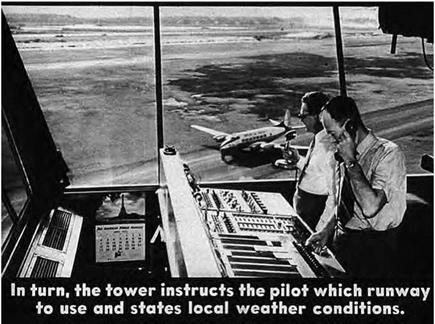The Quest for Safety Amid Crowded Skies
James Banke
Since 1926 and the passage of the Air Commerce Act, the Federal Government has had a vital commitment to aviation safety. Even before this, however, the NACA championed regulation of aeronautics, the establishment of licensing procedures for pilots and aircraft, and the definition of technical criteria to enhance the safety of air operations. NASA has worked closely with the FAA and other aviation organizations to ensure the safety of America’s air transport network.
HEN THE FIRST AIRPLANE LIFTED OFF from the sands of Kitty Hawk during 1903, there was no concern of a midair collision with another airplane. The Wright brothers had the North Carolina skies all to themselves. But as more and more aircraft found their way off the ground and then began to share the increasing number of new airfields, the need to coordinate movements among pilots quickly grew. As flight technology matured to allow cross-country trips, methods to improve safe navigation between airports evolved as well. Initially, bonfires lit the airways. Then came light towers, two-way radio, omnidirectional beacons, radar, and—ultimately—Global Positioning System (GPS) navigation signals from space.[181]
Today, the skies are crowded, and the potential for catastrophic loss of life is ever present, as more than 87,000 flights take place each day over the United States. Despite repeated reports of computer crashes or bad weather slowing an overburdened national airspace system, air- related fatalities remain historically low, thanks in large part to the technical advances developed by the National Aeronautics and Space Administration (NASA), but especially to the daily efforts of some 15,000 air traffic controllers keeping a close eye on all of those airplanes.[182]
|
From an Australian government slide show in 1 956, the basic concepts of an emerging air traffic control system are explained to the public. Airways Museum & Civil Aviation Historical Society, Melbourne, Australia (www. airwaysmuseum. com). |
All of those controllers work for, or are under contract to, the Federal Aviation Administration (FAA), which is the Federal agency responsible for keeping U. S. skyways safe by setting and enforcing regulations. Before the FAA (formed in 1958), it was the Civil Aeronautics Administration (formed in 1941), and even earlier than that, it was the Department of Commerce’s Aeronautics Bureau (formed in 1926). That that administrative job today is not part of NASA’s duties is the result of decisions made by the White House, Congress, and NASA’s predecessor organization, the National Advisory Committee for Aeronautics (NACA), during 1920.[183]
At the time (specifically 1919), the International Commission for Air Navigation had been created to develop the world’s first set of rules for governing air traffic. But the United States did not sign on to the convention. Instead, U. S. officials turned to the NACA and other organizations to determine how best to organize the Government for handling
all aspects of this new transportation system. The NACA in 1920 already was the focal point of aviation research in the Nation, and many thought it only natural, and best, that the Committee be the Government’s allinclusive home for aviation matters. A similar organizational model existed in Europe but didn’t appear to some with the NACA to be an ideal solution. This sentiment was most clearly expressed by John F. Hayford, a charter member of the NACA and a Northwestern University engineer, who said during a meeting, "The NACA is adapted to function well as an advisory committee but not to function satisfactorily as an administrative body.”[184]
So, in a way, NASA’s earliest contribution to making safer skyways was to shed itself of the responsibility for overseeing improvements to and regulating the operation of the national airspace. With the FAA secure in that management role, NASA has been free to continue to play to its strengths as a research organization. It has provided technical innovation to enhance safety in the cockpits; increase efficiencies along the air routes; introduce reliable automation, navigation, and communication systems for the many air traffic control (ATC) facilities that dot the Nation; and manage complex safety reporting systems that have required creation of new data-crunching capabilities.
This case study will present a survey in a more-or-less chronological order of NASA’s efforts to assist the FAA in making safer skyways. An overview of key NASA programs, as seen through the eyes of the FAA until 1996, will be presented first. NASA’s contributions to air traffic safety after the 1997 establishment of national goals for reducing fatal air accidents will be highlighted next. The case study will continue with a survey of NASA’s current programs and facilities related to airspace safety and conclude with an introduction of the NextGen Air Transportation System, which is to be in place by 2025.











